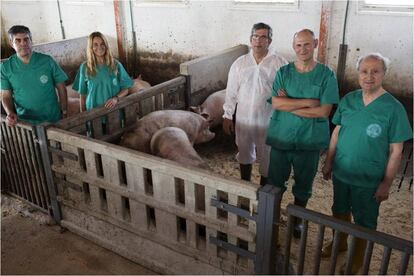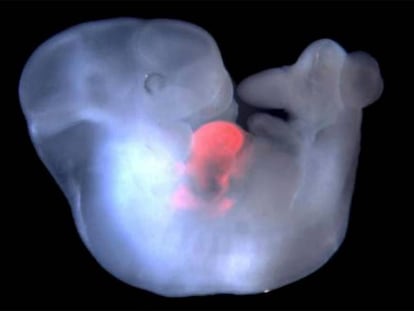International team of researchers creates 132 human-monkey embryos in China
The project is aimed at helping develop organs for transplantation, but it has drawn criticism over ethical concerns

A team of researchers led by the Spanish scientist Juan Carlos Izpisúa has created 132 human-monkey embryos in a laboratory in China, in a controversial experiment first revealed by EL PAÍS in the summer of 2019 and now officially published in detail.
Three of the embryos, which grew to contain up to 10,000 cells, developed for 19 days outside the uterus, at which point the researchers interrupted the study, they said in an article published by the scientific journal Cell on April 15. Scientists use the term “chimera” from Greek mythology to refer to these hybrids, in reference to a creature with the head of a lion, a goat’s head on its back and a snake’s head for a tail.
Izpisúa, 61, who is originally from Albacete in Spain, said that the real objective is the creation of human-pig chimeras, with the ultimate goal of growing human organs in pigs. The World Health Organization (WHO) estimates that some 130,000 transplants are performed globally annually, but this is less than 10% of those needed. “Every year tens of thousands of patients die on the waiting list for an organ,” Izpisúa said. Growing organs in pigs would solve this problem, he believes.
Izpisúa’s group is made up of members of the Salk Institute for Biological Sciences in La Jolla, California, and of Murcia Catholic University (UCAM) in Spain. The team already announced the creation of rudimentary human-pig chimeras in 2017, but these contained barely one human cell for every 100,000 pig cells. The scientists chose macaque monkeys for their next chimera study given the much closer genetic ancestry they share with humans, and with hopes of better understanding why the pig experiment failed.
The researchers retrieved eggs from a dozen female crab-eating macaques and fertilized them with sperm from the same species. After six days of cultivation in the laboratory, they had obtained 132 embryos, each containing 110 animal cells. The team then took 25 human cells that had been reprogrammed back to an embryonic stage to make them capable of becoming anything from skin cells to heart or liver cells (known as induced pluripotent stem cells), and injected them into the monkey embryos.
Nineteen days later, three of these embryos had reached the size of 10,000 cells, with human content of up to 7%. The experiments were carried out at the Yunnan Key Laboratory of Primate Biomedical Research, a facility that holds thousands of monkeys in the Chinese city of Kunming.
The announcement of the study’s results unleashed both stringent criticism and applause. British biologist Christine Mummery, president of the International Society for Stem Cell Research, warned that human-animal chimeras “are crossing established ethical and scientific boundaries.” Her organization will issue new guidelines in May regarding this type of research. Mummery, of the University of Leiden (Netherlands), said that she felt unsure if the means justified an end that could be very far off for Izpisúa and his team. “The results of the experiments are interesting, but justifying them in the context of regenerative medicine to generate human organs in animals for transplants seems to me a very distant goal,” she said. There are, she added, “more ethically acceptable” alternatives to the use of monkey embryos.
Federico de Montalvo, president of the Spanish Bioethics Committee and a professor of constitutional law at Comillas Pontifical University, asked why the experiments were carried out in China rather than in Spain or the United States: “Is it because they are scientifically more advanced or is it because ethically they are more relaxed?” De Montalvo is concerned about the unintended consequences of the research. “What they are aiming for is to be applauded, but perhaps one should also consider whether it could be used for other purposes, like creating some kind of in-between species. The risk is in opening up a path that other people could follow,” he reflected.

Scientists have experimented in this area for some time. In the mid-1920s, the Russian zoologist Ilya Ivanov, supported by the Soviet authorities of the time, tried to create chimpanzee-human hybrids by artificially inseminating females. Ivanov travelled to what is known today as Guinea-Conakry in West Africa with the intention of capturing apes for his experiments, but failed to achieve any results with them.
The idea of a half-human, half-animal creature remains science fiction for the time being, but potentially not for much longer. “We don’t know if human-monkey embryos would be biologically possible, but our goal in chimera research is not to develop new organisms, but to better understand how humans function in order to develop treatments for disease,” said Izpisúa.
Elsewhere, French biologist Pierre Savatier’s team published details three months ago of their attempt to create human-monkey chimeras in his laboratory at the University of Lyon. In that case, researchers only achieved a maximum of 10 human cells within monkey embryos composed of 250 cells that lived for seven days, according to Spanish biochemist and co-author of the study Manuel Serrano. Izpisúa used a different chemical cocktail on the human cells that he implanted in the monkey embryos. This allowed him to obtain embryos with around 7% of human cells that survived for 19 days. “His cells work spectacularly well,” said Serrano, of the Institute for Biomedical Research in Barcelona. “The reality is that Izpisúa is breaking down barriers. We are not going to have human organs growing in animals tomorrow, but that’s science. We’re learning,” he added.
Renowned Polish biologist Magdalena Zernicka-Goetz said the study was an “impressive” show of how human cells could integrate into a macaque embryo, but warned of the difficulty of controlling where these human cells travel, as they could potentially end up in an unwanted organ. Izpisúa argues that the technology already exists to prevent human neurons from forming in an animal brain, for example. “In the hypothetical case of being able to generate a live pig with human cells, we could prevent such scenarios,” he said. Zernicka-Goetz, a professor of mammalian development and stem cell biology in the Department of Physiology, Development and Neuroscience at the University of Cambridge, nonetheless wants society to discuss “the ethical implications” of these experiments.
Another Spanish biologist, Alfonso Martínez Arias, disagrees. It was “unnecessary to open this Pandora’s box”, he said, and his own group at the University of Cambridge last year produced structures similar to a human embryo that lived to around 20 days old. Created from embryonic stem cells developed in a lab, they grew components of a heart and nervous system, but could not form a brain. Martínez Arias believes that his laboratory pseudo-embryos could be an alternative to monkey chimeras for studying the development of human organs.
Martínez Arias, who recently joined Pompeu Fabra University in Barcelona, is highly critical of Izpisúa’s experiments in China, which he describes as being “of dubious ethics” and “low technical quality.” The viability of the chimeras has not been established, he argued. “This type of experiment can generate unjustified fears in society and endanger the work of other scientists who are trying to create an ethical and legal framework for related research,” said Martínez Arias.
Medical law specialist Carlos Romeo of the University of the Basque Country said he saw “no problem” with how Izpisúa’s research was conducted, as long as the embryos are not implanted into a uterus or cultivated in the laboratory for too long. “I have no criticisms on an ethical basis, and there is nothing that these experiments could be legally prosecuted for,” he said. Romeo is the only Spanish member of the scientific ethics committee that advises the President of the European Commission Ursula von der Leyen. He recalled that in the 1970s the so-called hamster test was developed, in which human sperm penetrated hamster eggs. “An animal was fertilized and no one was scandalized,” he noted.

A Spanish law from 2006 prohibits the creation of hybrids of different species that include human genetic material, but confusingly adds “except in the cases of currently permitted tests”. Romeo believes that Izpisúa’s experiments could be carried out in the European Union, and in fact the 2017 human-pig chimeras were largely carried out in Spain’s southeastern region of Murcia. Two of the co-authors of that study, the biologist Estrella Núñez and the veterinarian Llanos Martínez, are named as co-authors in the new human-monkey chimera study.
Research with human embryos left over from fertility clinics is limited by a strict international deadline of 14 days, i.e. the moment of development when the concept of the individual is supposedly created. From that point on, the embryo can no longer divide into two or more siblings. Working with Zernicka-Goetz, Spanish biologist Marta Shahbazi developed a method to cultivate embryos outside the uterus up to that 14-day limit in 2016. Izpisúa’s team has gone further with their human-monkey chimeras at 19 days, just before the nervous system begins to develop.
Shahbazi applauded the new research. “This study shows that chimeras do form. It seems like their system works and that it’s efficient,” she said. Shahbazi believes that human-monkey chimeras are “a very useful system” for studying embryonic development. “It’s a complementary tool for understanding basic biology,” she said. “Later, that knowledge could be used to go back to the pig and form a model for creating human organs in farm animals. That would be the ideal.”
Tu suscripción se está usando en otro dispositivo
¿Quieres añadir otro usuario a tu suscripción?
Si continúas leyendo en este dispositivo, no se podrá leer en el otro.
FlechaTu suscripción se está usando en otro dispositivo y solo puedes acceder a EL PAÍS desde un dispositivo a la vez.
Si quieres compartir tu cuenta, cambia tu suscripción a la modalidad Premium, así podrás añadir otro usuario. Cada uno accederá con su propia cuenta de email, lo que os permitirá personalizar vuestra experiencia en EL PAÍS.
¿Tienes una suscripción de empresa? Accede aquí para contratar más cuentas.
En el caso de no saber quién está usando tu cuenta, te recomendamos cambiar tu contraseña aquí.
Si decides continuar compartiendo tu cuenta, este mensaje se mostrará en tu dispositivo y en el de la otra persona que está usando tu cuenta de forma indefinida, afectando a tu experiencia de lectura. Puedes consultar aquí los términos y condiciones de la suscripción digital.
More information
Archived In
Últimas noticias
Most viewed
- Sinaloa Cartel war is taking its toll on Los Chapitos
- Oona Chaplin: ‘I told James Cameron that I was living in a treehouse and starting a permaculture project with a friend’
- Reinhard Genzel, Nobel laureate in physics: ‘One-minute videos will never give you the truth’
- Why the price of coffee has skyrocketed: from Brazilian plantations to specialty coffee houses
- Silver prices are going crazy: This is what’s fueling the rally











































